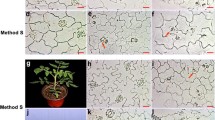Abstract
A cDNA clone with sequence homology to soluble inorganic pyrophosphatase (IPPase) was isolated from a library of developing barley grains. The protein encoded by this clone was produced in transgenic Escherichia coli, and showed IPPase activity. In nondormant barley grains, the gene appeared to be expressed in metabolically active tissue such as root, shoot, embryo and aleurone. During imbibition, a continuous increase of the steady state mRNA level of IPPase was observed in embryos of non-dormant grains. In the embryos of dormant grains its production declined, after an initial increase. With isolated dormant and nondormant embryos, addition of recombinant IPPase, produced by E. coli, enhanced the germination rate. On the other hand, addition of pyrophosphate (PPi), substrate for this enzyme, appeared to reduce the germination rate. A role for this IPPase in germination is discussed.
Similar content being viewed by others
References
Black M: Abscisic acid in seed germination and dormancy. In: Addicott FT (ed) Abscisic Acid, pp. 337–363. Praeger P, New York (1983).
Brandao MEG, Aoyama H: Effect of cations on themaize germ inorganic pyrophosphatase activity. Plant Physiol Biochem 31: 937–941 (1993).
Cooperman BS, Baykov AA, Lahti R: Evolutionary conservation of the active site of soluble inorganic pyrophosphatase. Trends Biochem Sci 17: 262–264 (1992).
Du Jardin P, Rojas-Beltran J, Gebhardt C, Brasseur R: Molecular cloning and characterization of a soluble inorganic pyrophosphatase in potato. Plant Physiol 109: 853–860 (1995).
Garciarrubio A, Legaria JP, Covarrubias AA: Abscisic acid inhibits germination of mature Arabidopsis seeds by limiting the availability of energy and nutrients. Planta 203: 182–187 (1997).
Goodwin TW, Mercer EI: Introduction to Plant Biochemistry, 2nd ed. Pergamon Press, Oxford, UK (1990).
Heimovaara-Dijkstra S: Signals mediating ABA action in barley grain. Ph.D. thesis, Leiden University, Leiden, Netherlands (1995).
Holtman WL, Heistek JC, Mattern KA, Bakhuizen R, Douma AC: βoxidation of fatty acids is linked to the glyoxylate cycle in the aleurone but not in the embryo of germinating barley. Plant Sci 99: 43–53 (1994).
Jelitto T, Sonnewald U, Willmitzer L, Hajirezeai M, Stitt M: Inorganic pyrophosphate content and metabolites in potato and tobacco plants expressing E. coli pyrophosphatase in their cytosol. Planta 188: 238–244 (1992).
Karssen CM, Haigh A, van der Toorn P, Weges R: Physiological mechanism involved in seed priming. In: RB Tayorson (ed) Recent Advances in the Development and Germination of Seeds. NATO ASI Series, vol. 187, pp. 269–280 (1989).
Kieber JJ, Signer ER: Cloning and characterization of an inorganic pyrophosphatase gene from Arabidopsis thaliana. Plant Mol Biol 16: 345–348 (1991).
Laemmli: Cleavage of structural proteins during assembly of the head of bacteriophage T4. Nature 227: 680–685 (1970).
Lerchl J, Geigenberger P, Stitt M, Sonnewald U: Impaired photoassimilate partitioning caused by phloemspecific removal of pyrophosphate can be complemented by a phloemspecific cytosolic yeastderived invertase in transgenic plants. Plant J 7: 259–270 (1995).
Mortain-Bertrand A, Uteau F, Enault N, D'Harlingue A, Schaeffer J, Lamant A: Characterization of alkaline inorganic pyrophosphatase from Capsicum annuum chromoplasts. Plant Physiol Biochem 30: 779–788 (1992).
Mundy J, Yamaguchi-Shinozaki K, Chua NH: Nuclear proteins bind conserved elements in the abscisic acid responsive promoter of a rice rab gene. Proc Natl Acad Sci USA 87: 1406–1410 (1990).
Rea PA, Kim Y, Sarafian V, Poole RJ, Davies J, Sanders D: Vacuolar H+-translocating pyrophosphatases: a new catagory of ion translocase. Trends Biochem Sci 17: 348–353 (1992).
Sambrook J, Fritsch EF, Maniatis T: Molecular Cloning: A Laboratory Manual, 2nd ed. Cold Spring Harbor Laboratory Press, Cold Spring Harbor, NY (1989).
Sanger F, Nicklen S, Coulson AR: DNAsequencing with chain terminating inhibitors. Proc Natl Acad SciUSA 83: 8073–8077 (1977).
Schuurink RC, van Beckum JMM, Heidekamp F: Modulation of grain dormancy in barley by variation of plant growth conditions. Hereditas 117: 137–143 (1992).
Sonnewald U: Expression of E. coli inorganic pyrophosphatase in transgenic plants alters photoassimilate partitioning. Plant J 2: 571–581 (1992).
van Beckum JMM, Libbenga KR, Wang M: Abscisic acid and gibberellic acidregulated responses of embryos and aleurone layers isolated from dormant and nondormant barley grains. Physiol Plant 89: 483–489 (1993).
Visser K, Vissers APA, Cağirgan MI, Kijne JW, Wang M: Rapid germination of a barley mutant is correlated with a rapid turnover of abscisic acid outside the embryo. Plant Physiol 111: 1127–1133 (1996).
Walker-Simmons M: ABA levels and sensitivity in developing wheat embryos of sprouting resistant and susceptible cultivars. Plant Physiol 84: 61–66 (1987).
Walker-Simmons M, Sesing J: Temperature effects on embryonic abscisic acid levels during development of wheat grain dormancy. J Plant Growth Regul 9: 51–56 (1990).
Wan YS, Tang JD, Chang NG, Zhou X, Du NX: Purification and identification of ABA binding protein of microsomal vesicles from corn root tips by affinity chromatography in conjunction with ELISA. Plant Physiol Commun 27: 361–363 (1991).
Wan YS, Hasenstein KH: Immunological evidence for ABA receptors in corn roots. Plant Physiol 102: S336 (1993).
Wang M, van Duijn B, van der Meulen RM, Heidekamp F: Effect of abscisic acid analogues on intracellular calcium level and gene expression in barley aleurone protoplasts. In: Karssen CM, van Loon LC, Vreugdenhil D (eds) Progress in Plant Growth Regulation, pp. 635–642. Kluwer Academic Publishers, Dordrecht, Netherlands (1992).
Wang M, Bakhuizen R, Heimovaara-Dijkstra S, Zeijl MJ, de Vries MA, van Beckum JMM, Sinjorgo KMC: The role of ABA and GA in barley grain dormancy: a comparative study between embryo dormancy and aleurone dormancy. Russ J Plant Physiol 41: 577–584 (1994).
Wang M, Heimovaara-Dijkstra S, van Duijn B: Modulation of germination of embryos isolated from dormant and nondormant barley grains by manipulation of endogenous abscisic acid levels. Planta 195: 586–592 (1995).
Author information
Authors and Affiliations
Rights and permissions
About this article
Cite this article
Visser, K., Heimovaara-Dijkstra, S., Kijne, J.W. et al. Molecular cloning and characterization of an inorganic pyrophosphatase from barley. Plant Mol Biol 37, 131–140 (1998). https://doi.org/10.1023/A:1005931003483
Issue Date:
DOI: https://doi.org/10.1023/A:1005931003483




